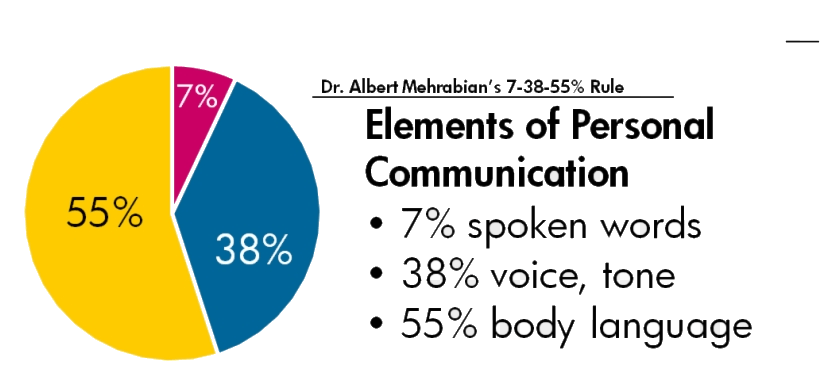How Much of Communication is Nonverbal?

Did you know that you are always communicating to those around you? Intentionally or otherwise, verbally or nonverbally, you are always saying something. Being aware of what we’re communicating is necessary to ensure that we are accurately conveying whatever message we want to get across. This awareness results in a higher degree of clarity increased trust, and stronger professional and personal relationships.
What Is Nonverbal Communication?
Nonverbal communication incorporates many areas that include physical expressions, posture, mannerisms, eye contact, gestures, tone of voice, and other ways people communicate without speaking. Your body language can either build trust in your listener, strengthening your message, or it can offend them and cause them to not believe in the information you are speaking to. You should stay away from smiles or laughter when addressing matters of a serious nature. You should also avoid glancing at clocks, your watch, or other possible distractions, as these will communicate disinterest in your information or even your audience.
Interestingly, much of what we communicate is done unconsciously, so we may have no idea what message we’re actually projecting. If you’re facing an interview, it would be prudent to practice answering any anticipated questions in preparation. However, it is also essential to understand how you are communicating non-verbally for that interview as well as in any situation, professional or personal.
Most public speakers video record themselves rehearsing their speech so they can see what their audience is seeing. You may also want to try this, and you may be surprised at what you observe about yourself! Do use this tool as an opportunity to improve your overall presentation and refine your skills.
Be Consistent
Our nonverbal methods to communicate can sometimes be at odds with our words. We may say one thing while our body language says another. When this happens, we are sending mixed messages that confuse the listener, creating uncertainty, and possibly promoting distrust.
Eye contact with an individual for three to four seconds before moving to another in an audience will convey confidence in your message, while shifting your focus quickly away from someone can indicate insecurity, anxiety, or evasion. Sitting with arms crossed can indicate resistance to what is being said, although it could also mean the person is merely cold! Context is essential, but in any case, being aware of and improving your body language is critical to your success.
How Much of Communication is Non-Verbal?
You’ve probably heard it said that most of what we communicate is accomplished through nonverbal methods: 93 percent, to be exact. This came to be known as the 7% Rule, where all communication is only seven percent verbal and an overwhelming 93 percent non-verbal, specifically, body language and varying tones of speech.
The numbers represent the percentages of importance that can be attributed to various forms of communication. Fifty-five percent of information delivered was determined to be through body language, 38 percent through the tone of voice, and only seven percent through the actual spoken words.
Where Did These Numbers Originate?
These percentages have been attributed to Albert Mehrabian’s research on non-verbal communication, as published in his 1971 book, Silent Messages. It was actually, however, two research studies by Mehrabian and Ferris that were combined, which resulted in the 55/38/7 formula. These were limited experiments that ended up taking on a life of their own, becoming an oft-cited but misleading statistic.
Also, the first study consisted of an even earlier formula, the 60/40 percentage breakdown. This formula represented the comparison of importance between vocal, which is 40 percent, and facial, which is 60 percent, components relating to a person’s attitude.
What Was Mehrabian’s Intent?
Mehrabian created this formula for a specific context, when someone is communicating in a way that their verbal signals don’t match their non-verbal ones. In that case, Mehrabian states: “When there are inconsistencies between attitudes communicated verbally and posturally, the postural component should dominate in determining the total attitude that is inferred.”
While he developed this formula specifically for detecting inconsistencies in a speaker message due to their body language, we can also apply it in the reverse to strengthen our messages.
Types of Non-Verbal Communication
Facial Expressions
Are you offering a friendly smile at the right time? Looking serious or thoughtful when appropriate? Be sincerely engaged in your conversations, and let your interest reflect authentically in your facial expressions. Do you tend to roll your eyes often? Be aware of the negative message of disagreement that is projected.
Posture
Poor posture can often indicate a lack of self-confidence or inexperience. You don’t want to be rigid in your stance, but you do want to have good posture. There’s an old cue where you imagine having a string attached from your tailbone through the crown of your head and up to the ceiling, with someone gently pulling it up to lengthen your entire spine. You want to project relaxed confidence, poise, and capability.
Eye Contact
Are you maintaining eye contact to show you are engaged in the conversation or are you looking away much of the time? Looking away too often can indicate a lack of interest, a lack of respect, or even that you have something to hide. Conversely, staring without a break is considered rude and can be disconcerting, so you want to occasionally break your interested gaze before re-engaging in eye contact.
Attentiveness
Show that you are attentive, listening carefully so that you understand what the other person is saying and responding when appropriate. Don’t fidget, which will make you look uncomfortable, and that you can’t wait to get away from there.

Tone of Voice
The tone of your voice is considered non-verbal because it can modify or even completely contradict your actual words. The tone of your voice includes the pitch, inflection, intensity, and volume. Again, be sincere and let your tone of voice enhance what you’re saying.
Appearance
Your appearance includes everything about you that can be observed at a glance. It gives an overall and all-important first impression, and can communicate personal attitude or level of professionalism when presented in a style that is appropriate to the occasion. A well-fitting suit worn to an interview can communicate a level of professionalism and composure, while jeans and a t-shirt may come across as less-serious, unprofessional, or even slovenly.
Grooming
Your clothing should be clean, neat, pressed, sending the message that you attend to details in other areas of your life.
Hairstyle
Your hair should always look well-groomed, clean, and tidy in a style that is appropriate to your desired image. A fresh haircut, or cleanly styled hair can communicate approachability and professionalism, while a messy bed-head look will come across as lazy, even if it is a deliberately styled look.
Accessories
Your shoes, pocketbooks, jewelry, tie, and other accessories should complement your overall image and the message that you want to convey. A single necklace that compliments an outfit without distracting the eye can pull a look together, and speak to composure and a professional attire. Meanwhile, too many bracelets, or other pieces of jewelry that can become loud and distracting in motion will detract from what might be an otherwise professional outfit.
Elevate Your Communication Today
The image you present is critical to your success. It must match what you are saying if you want to be perceived as authentic as well as get your intended message across. Communication isn’t always verbal and comes through in many non-verbal ways as well.
Taking into consideration the way you dress, engage in conversation, and act will enable you to make a positive impact and take you a lot farther in your professional and personal relationships.
We will help you put it all together. We’ve been training professional image consultants for over 20 years, so that they can help men and women create the image they want to present in a variety of settings.
You can help many people make a powerful statement without even saying a word. Visit us at the London Image Institute to learn more information on working as an image consultant.
